Wawasan Open University: Analysis of Inclusive Education Report
VerifiedAdded on 2022/08/24
|8
|1774
|26
Report
AI Summary
This report provides an analysis of inclusive education in Malaysia, focusing on the government's 'Zero Reject Policy' implemented in 2019. It examines the policy's aim to provide education to all children, including those with disabilities, through mainstream schools and special programs. The report delves into the categorization of students with special needs, the importance of early intervention, and the role of parental involvement. Furthermore, it analyzes the impact of classroom environments on student learning, emphasizing the significance of cooperation and interaction among students. The report also explores various strategies for designing inclusive classrooms, including observation, portfolio assessment, analyzing learning rates, and reteaching methods. The conclusion highlights the benefits of inclusive education and the importance of effective classroom design and strategies to ensure quality education for all students.
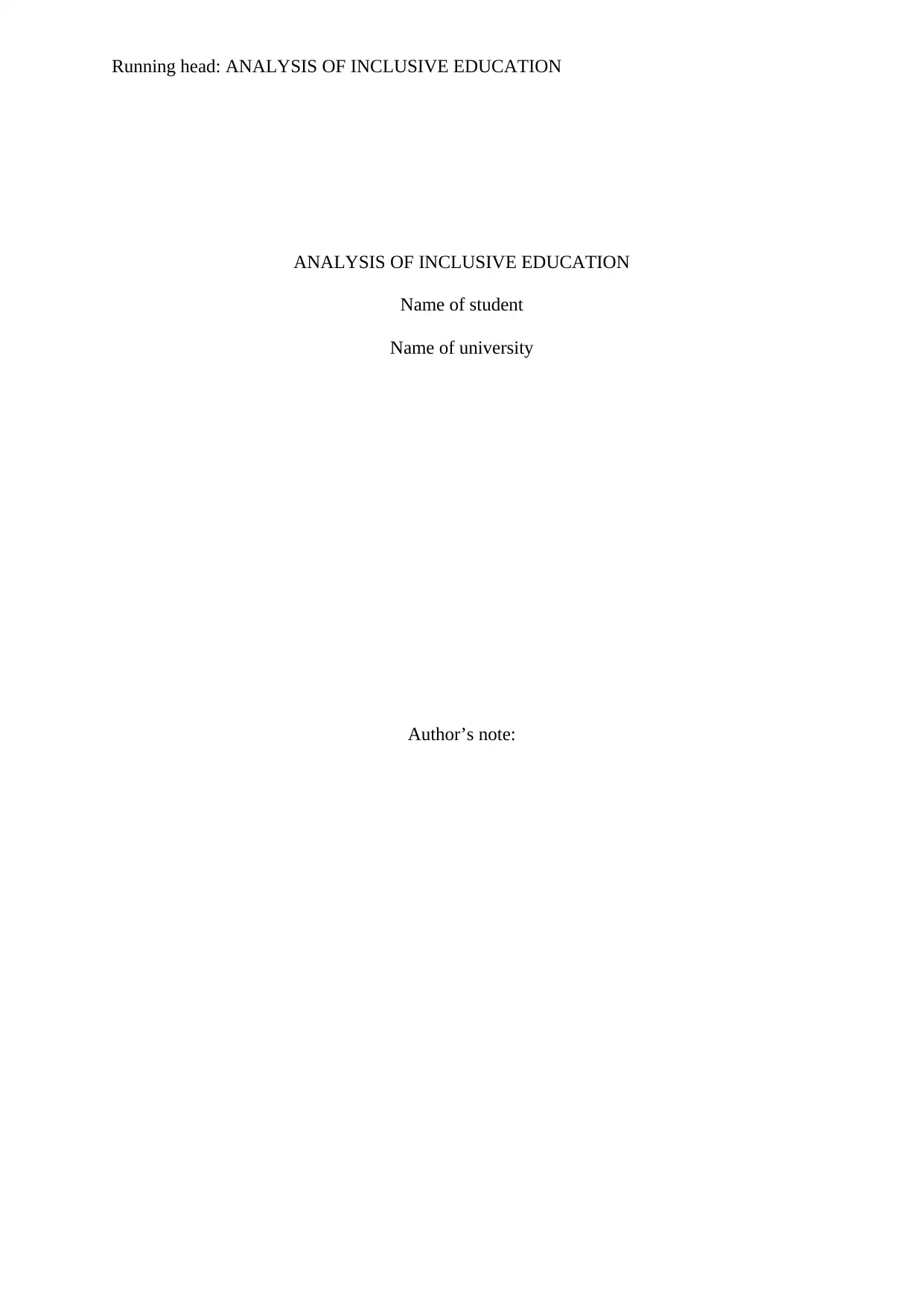
Running head: ANALYSIS OF INCLUSIVE EDUCATION
ANALYSIS OF INCLUSIVE EDUCATION
Name of student
Name of university
Author’s note:
ANALYSIS OF INCLUSIVE EDUCATION
Name of student
Name of university
Author’s note:
Paraphrase This Document
Need a fresh take? Get an instant paraphrase of this document with our AI Paraphraser
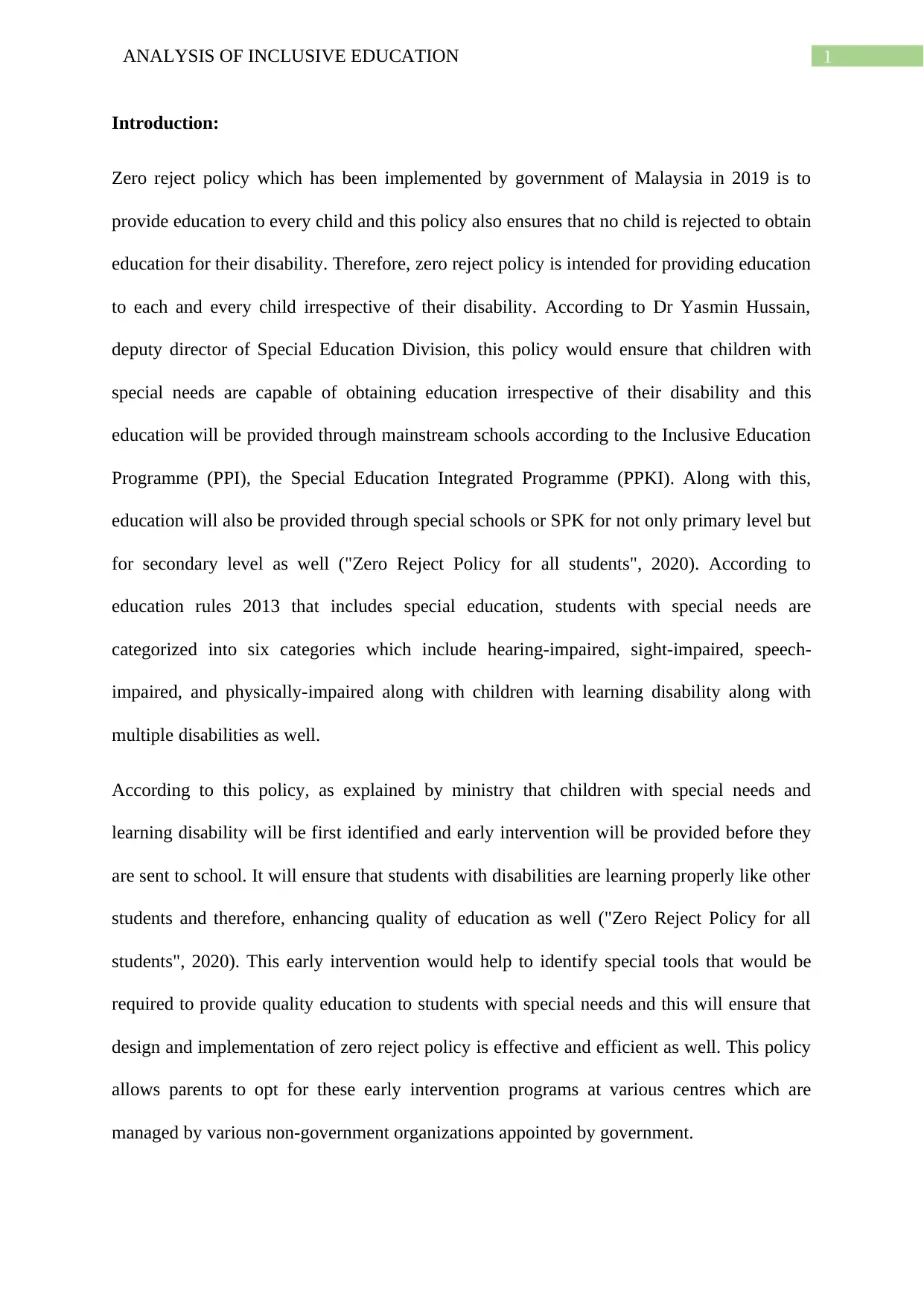
1ANALYSIS OF INCLUSIVE EDUCATION
Introduction:
Zero reject policy which has been implemented by government of Malaysia in 2019 is to
provide education to every child and this policy also ensures that no child is rejected to obtain
education for their disability. Therefore, zero reject policy is intended for providing education
to each and every child irrespective of their disability. According to Dr Yasmin Hussain,
deputy director of Special Education Division, this policy would ensure that children with
special needs are capable of obtaining education irrespective of their disability and this
education will be provided through mainstream schools according to the Inclusive Education
Programme (PPI), the Special Education Integrated Programme (PPKI). Along with this,
education will also be provided through special schools or SPK for not only primary level but
for secondary level as well ("Zero Reject Policy for all students", 2020). According to
education rules 2013 that includes special education, students with special needs are
categorized into six categories which include hearing-impaired, sight-impaired, speech-
impaired, and physically-impaired along with children with learning disability along with
multiple disabilities as well.
According to this policy, as explained by ministry that children with special needs and
learning disability will be first identified and early intervention will be provided before they
are sent to school. It will ensure that students with disabilities are learning properly like other
students and therefore, enhancing quality of education as well ("Zero Reject Policy for all
students", 2020). This early intervention would help to identify special tools that would be
required to provide quality education to students with special needs and this will ensure that
design and implementation of zero reject policy is effective and efficient as well. This policy
allows parents to opt for these early intervention programs at various centres which are
managed by various non-government organizations appointed by government.
Introduction:
Zero reject policy which has been implemented by government of Malaysia in 2019 is to
provide education to every child and this policy also ensures that no child is rejected to obtain
education for their disability. Therefore, zero reject policy is intended for providing education
to each and every child irrespective of their disability. According to Dr Yasmin Hussain,
deputy director of Special Education Division, this policy would ensure that children with
special needs are capable of obtaining education irrespective of their disability and this
education will be provided through mainstream schools according to the Inclusive Education
Programme (PPI), the Special Education Integrated Programme (PPKI). Along with this,
education will also be provided through special schools or SPK for not only primary level but
for secondary level as well ("Zero Reject Policy for all students", 2020). According to
education rules 2013 that includes special education, students with special needs are
categorized into six categories which include hearing-impaired, sight-impaired, speech-
impaired, and physically-impaired along with children with learning disability along with
multiple disabilities as well.
According to this policy, as explained by ministry that children with special needs and
learning disability will be first identified and early intervention will be provided before they
are sent to school. It will ensure that students with disabilities are learning properly like other
students and therefore, enhancing quality of education as well ("Zero Reject Policy for all
students", 2020). This early intervention would help to identify special tools that would be
required to provide quality education to students with special needs and this will ensure that
design and implementation of zero reject policy is effective and efficient as well. This policy
allows parents to opt for these early intervention programs at various centres which are
managed by various non-government organizations appointed by government.
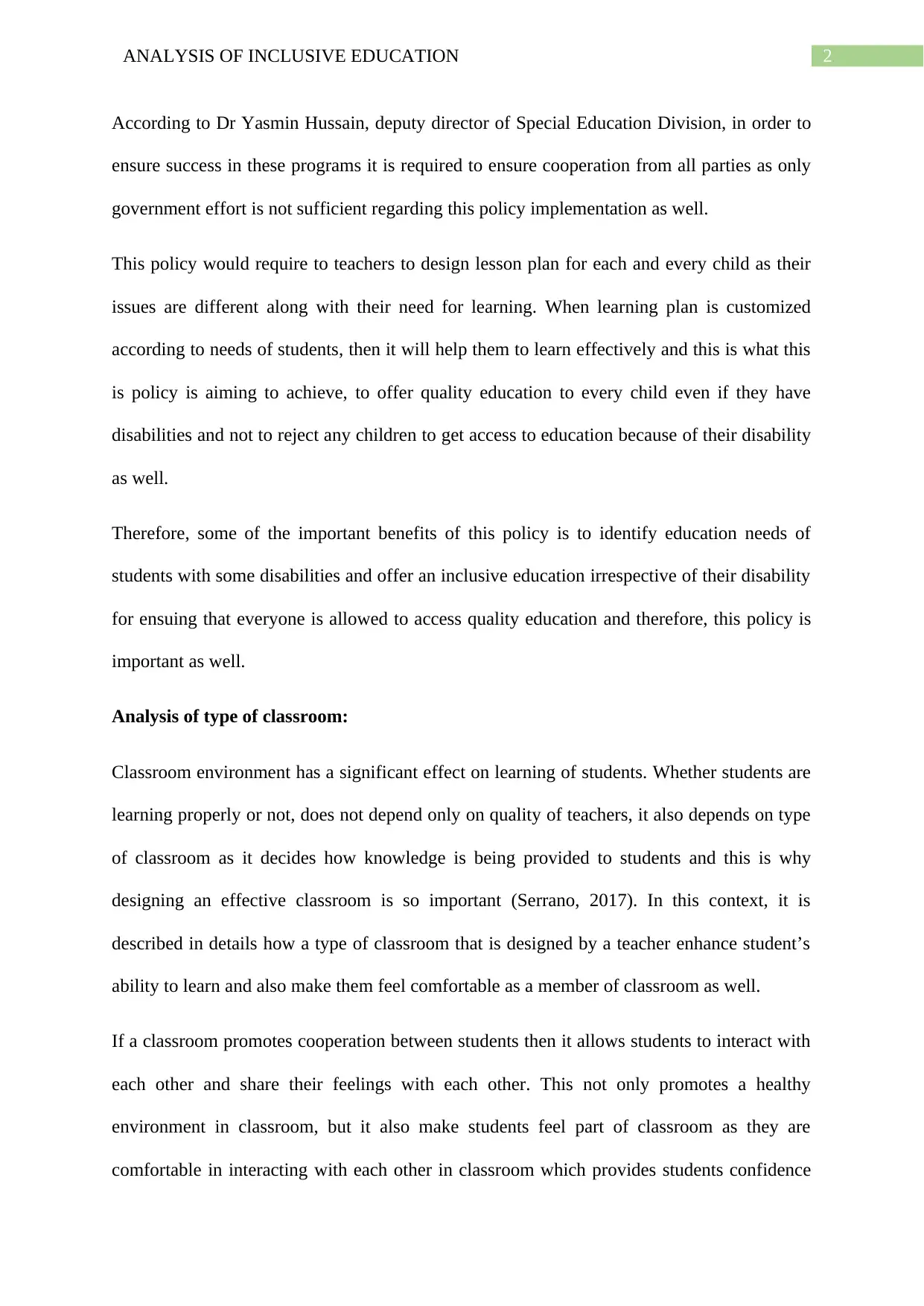
2ANALYSIS OF INCLUSIVE EDUCATION
According to Dr Yasmin Hussain, deputy director of Special Education Division, in order to
ensure success in these programs it is required to ensure cooperation from all parties as only
government effort is not sufficient regarding this policy implementation as well.
This policy would require to teachers to design lesson plan for each and every child as their
issues are different along with their need for learning. When learning plan is customized
according to needs of students, then it will help them to learn effectively and this is what this
is policy is aiming to achieve, to offer quality education to every child even if they have
disabilities and not to reject any children to get access to education because of their disability
as well.
Therefore, some of the important benefits of this policy is to identify education needs of
students with some disabilities and offer an inclusive education irrespective of their disability
for ensuing that everyone is allowed to access quality education and therefore, this policy is
important as well.
Analysis of type of classroom:
Classroom environment has a significant effect on learning of students. Whether students are
learning properly or not, does not depend only on quality of teachers, it also depends on type
of classroom as it decides how knowledge is being provided to students and this is why
designing an effective classroom is so important (Serrano, 2017). In this context, it is
described in details how a type of classroom that is designed by a teacher enhance student’s
ability to learn and also make them feel comfortable as a member of classroom as well.
If a classroom promotes cooperation between students then it allows students to interact with
each other and share their feelings with each other. This not only promotes a healthy
environment in classroom, but it also make students feel part of classroom as they are
comfortable in interacting with each other in classroom which provides students confidence
According to Dr Yasmin Hussain, deputy director of Special Education Division, in order to
ensure success in these programs it is required to ensure cooperation from all parties as only
government effort is not sufficient regarding this policy implementation as well.
This policy would require to teachers to design lesson plan for each and every child as their
issues are different along with their need for learning. When learning plan is customized
according to needs of students, then it will help them to learn effectively and this is what this
is policy is aiming to achieve, to offer quality education to every child even if they have
disabilities and not to reject any children to get access to education because of their disability
as well.
Therefore, some of the important benefits of this policy is to identify education needs of
students with some disabilities and offer an inclusive education irrespective of their disability
for ensuing that everyone is allowed to access quality education and therefore, this policy is
important as well.
Analysis of type of classroom:
Classroom environment has a significant effect on learning of students. Whether students are
learning properly or not, does not depend only on quality of teachers, it also depends on type
of classroom as it decides how knowledge is being provided to students and this is why
designing an effective classroom is so important (Serrano, 2017). In this context, it is
described in details how a type of classroom that is designed by a teacher enhance student’s
ability to learn and also make them feel comfortable as a member of classroom as well.
If a classroom promotes cooperation between students then it allows students to interact with
each other and share their feelings with each other. This not only promotes a healthy
environment in classroom, but it also make students feel part of classroom as they are
comfortable in interacting with each other in classroom which provides students confidence
⊘ This is a preview!⊘
Do you want full access?
Subscribe today to unlock all pages.

Trusted by 1+ million students worldwide
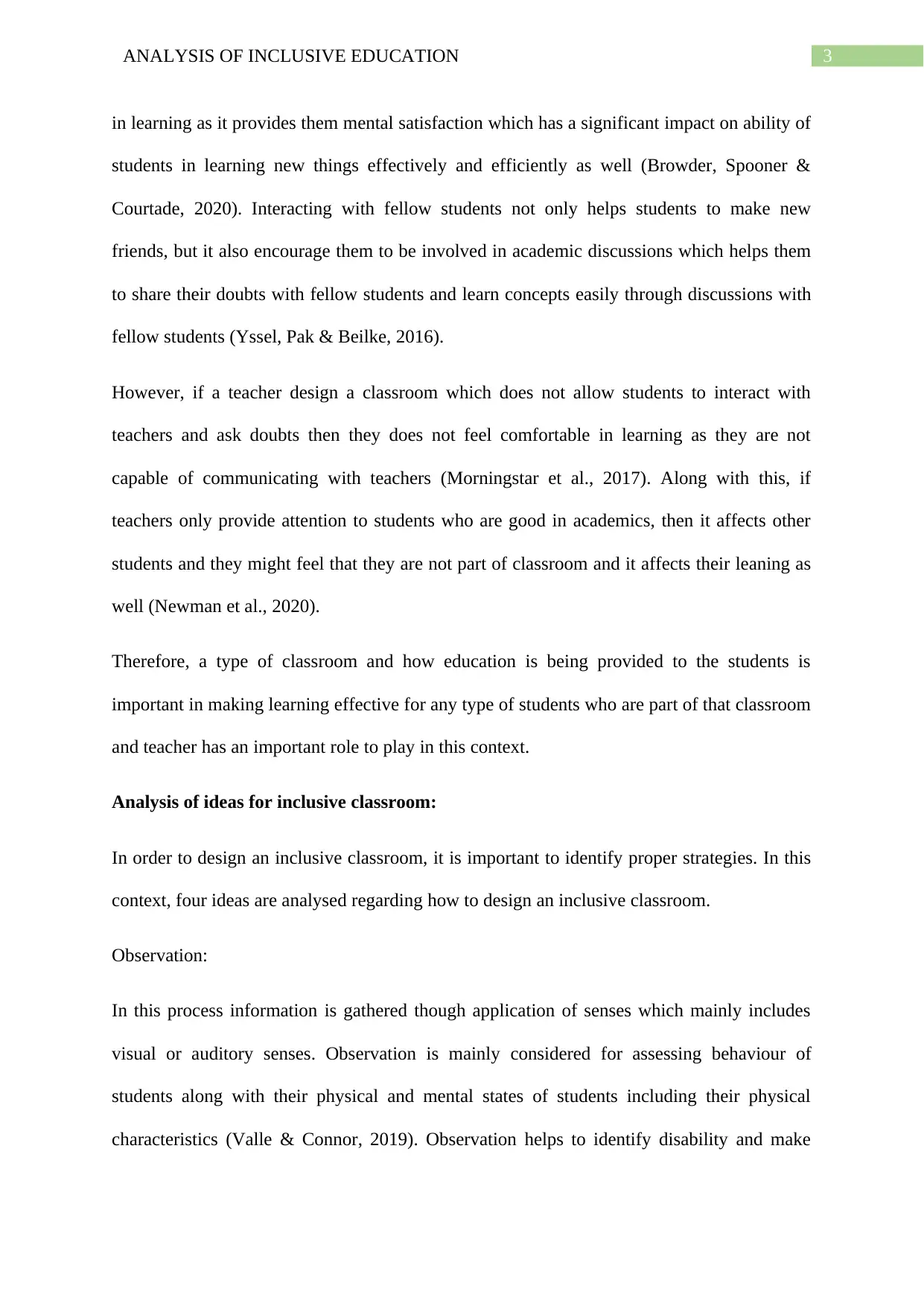
3ANALYSIS OF INCLUSIVE EDUCATION
in learning as it provides them mental satisfaction which has a significant impact on ability of
students in learning new things effectively and efficiently as well (Browder, Spooner &
Courtade, 2020). Interacting with fellow students not only helps students to make new
friends, but it also encourage them to be involved in academic discussions which helps them
to share their doubts with fellow students and learn concepts easily through discussions with
fellow students (Yssel, Pak & Beilke, 2016).
However, if a teacher design a classroom which does not allow students to interact with
teachers and ask doubts then they does not feel comfortable in learning as they are not
capable of communicating with teachers (Morningstar et al., 2017). Along with this, if
teachers only provide attention to students who are good in academics, then it affects other
students and they might feel that they are not part of classroom and it affects their leaning as
well (Newman et al., 2020).
Therefore, a type of classroom and how education is being provided to the students is
important in making learning effective for any type of students who are part of that classroom
and teacher has an important role to play in this context.
Analysis of ideas for inclusive classroom:
In order to design an inclusive classroom, it is important to identify proper strategies. In this
context, four ideas are analysed regarding how to design an inclusive classroom.
Observation:
In this process information is gathered though application of senses which mainly includes
visual or auditory senses. Observation is mainly considered for assessing behaviour of
students along with their physical and mental states of students including their physical
characteristics (Valle & Connor, 2019). Observation helps to identify disability and make
in learning as it provides them mental satisfaction which has a significant impact on ability of
students in learning new things effectively and efficiently as well (Browder, Spooner &
Courtade, 2020). Interacting with fellow students not only helps students to make new
friends, but it also encourage them to be involved in academic discussions which helps them
to share their doubts with fellow students and learn concepts easily through discussions with
fellow students (Yssel, Pak & Beilke, 2016).
However, if a teacher design a classroom which does not allow students to interact with
teachers and ask doubts then they does not feel comfortable in learning as they are not
capable of communicating with teachers (Morningstar et al., 2017). Along with this, if
teachers only provide attention to students who are good in academics, then it affects other
students and they might feel that they are not part of classroom and it affects their leaning as
well (Newman et al., 2020).
Therefore, a type of classroom and how education is being provided to the students is
important in making learning effective for any type of students who are part of that classroom
and teacher has an important role to play in this context.
Analysis of ideas for inclusive classroom:
In order to design an inclusive classroom, it is important to identify proper strategies. In this
context, four ideas are analysed regarding how to design an inclusive classroom.
Observation:
In this process information is gathered though application of senses which mainly includes
visual or auditory senses. Observation is mainly considered for assessing behaviour of
students along with their physical and mental states of students including their physical
characteristics (Valle & Connor, 2019). Observation helps to identify disability and make
Paraphrase This Document
Need a fresh take? Get an instant paraphrase of this document with our AI Paraphraser
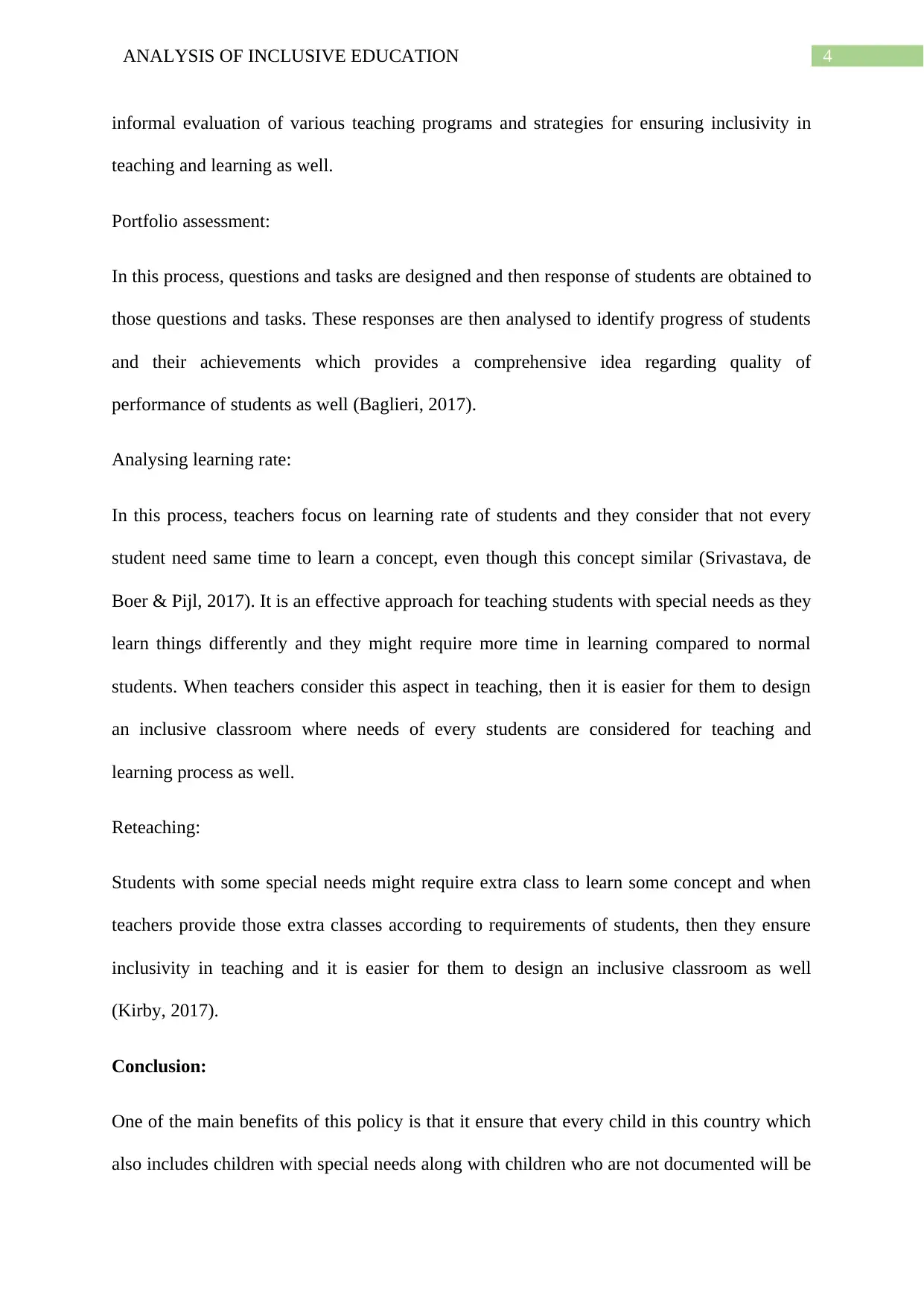
4ANALYSIS OF INCLUSIVE EDUCATION
informal evaluation of various teaching programs and strategies for ensuring inclusivity in
teaching and learning as well.
Portfolio assessment:
In this process, questions and tasks are designed and then response of students are obtained to
those questions and tasks. These responses are then analysed to identify progress of students
and their achievements which provides a comprehensive idea regarding quality of
performance of students as well (Baglieri, 2017).
Analysing learning rate:
In this process, teachers focus on learning rate of students and they consider that not every
student need same time to learn a concept, even though this concept similar (Srivastava, de
Boer & Pijl, 2017). It is an effective approach for teaching students with special needs as they
learn things differently and they might require more time in learning compared to normal
students. When teachers consider this aspect in teaching, then it is easier for them to design
an inclusive classroom where needs of every students are considered for teaching and
learning process as well.
Reteaching:
Students with some special needs might require extra class to learn some concept and when
teachers provide those extra classes according to requirements of students, then they ensure
inclusivity in teaching and it is easier for them to design an inclusive classroom as well
(Kirby, 2017).
Conclusion:
One of the main benefits of this policy is that it ensure that every child in this country which
also includes children with special needs along with children who are not documented will be
informal evaluation of various teaching programs and strategies for ensuring inclusivity in
teaching and learning as well.
Portfolio assessment:
In this process, questions and tasks are designed and then response of students are obtained to
those questions and tasks. These responses are then analysed to identify progress of students
and their achievements which provides a comprehensive idea regarding quality of
performance of students as well (Baglieri, 2017).
Analysing learning rate:
In this process, teachers focus on learning rate of students and they consider that not every
student need same time to learn a concept, even though this concept similar (Srivastava, de
Boer & Pijl, 2017). It is an effective approach for teaching students with special needs as they
learn things differently and they might require more time in learning compared to normal
students. When teachers consider this aspect in teaching, then it is easier for them to design
an inclusive classroom where needs of every students are considered for teaching and
learning process as well.
Reteaching:
Students with some special needs might require extra class to learn some concept and when
teachers provide those extra classes according to requirements of students, then they ensure
inclusivity in teaching and it is easier for them to design an inclusive classroom as well
(Kirby, 2017).
Conclusion:
One of the main benefits of this policy is that it ensure that every child in this country which
also includes children with special needs along with children who are not documented will be
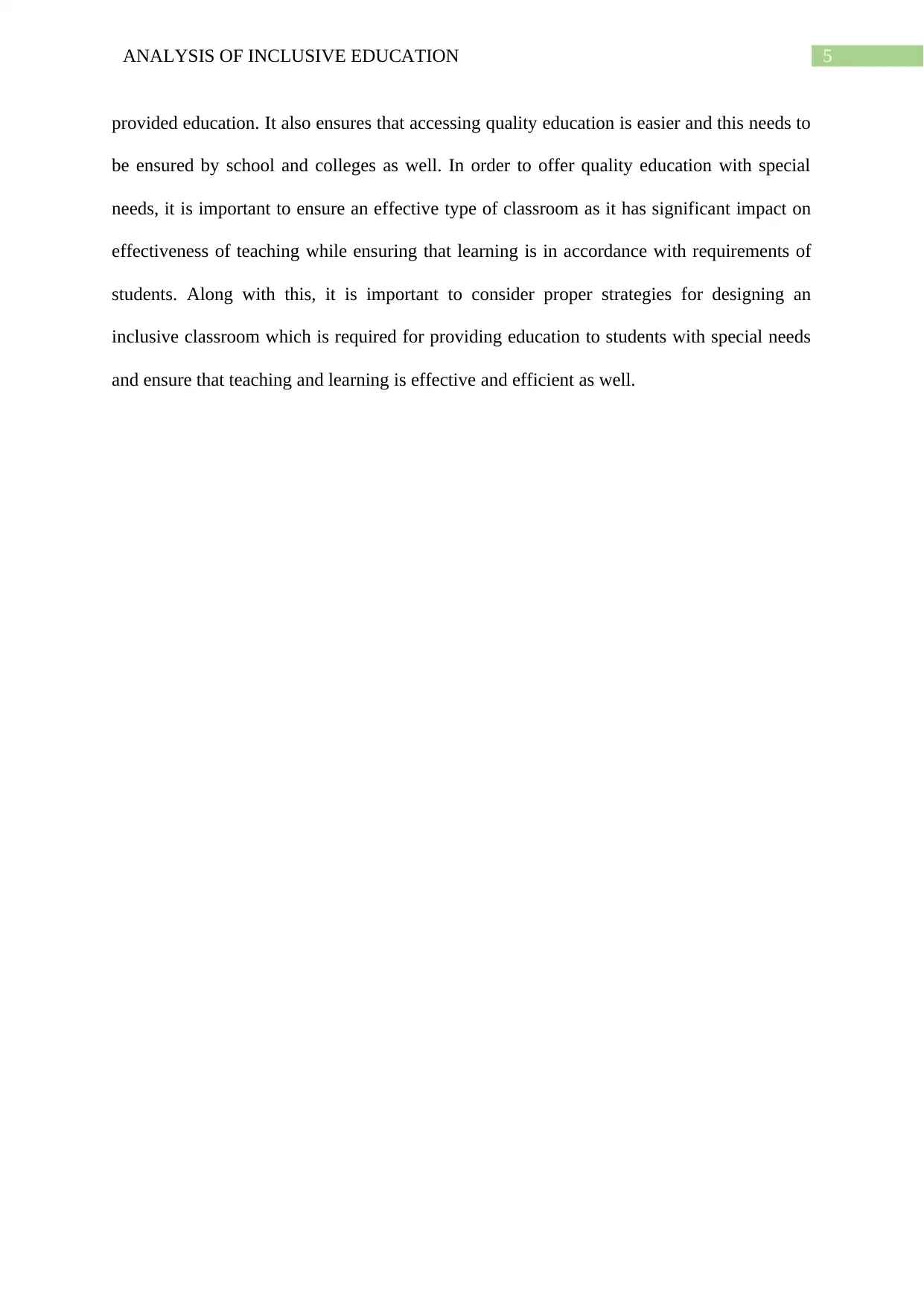
5ANALYSIS OF INCLUSIVE EDUCATION
provided education. It also ensures that accessing quality education is easier and this needs to
be ensured by school and colleges as well. In order to offer quality education with special
needs, it is important to ensure an effective type of classroom as it has significant impact on
effectiveness of teaching while ensuring that learning is in accordance with requirements of
students. Along with this, it is important to consider proper strategies for designing an
inclusive classroom which is required for providing education to students with special needs
and ensure that teaching and learning is effective and efficient as well.
provided education. It also ensures that accessing quality education is easier and this needs to
be ensured by school and colleges as well. In order to offer quality education with special
needs, it is important to ensure an effective type of classroom as it has significant impact on
effectiveness of teaching while ensuring that learning is in accordance with requirements of
students. Along with this, it is important to consider proper strategies for designing an
inclusive classroom which is required for providing education to students with special needs
and ensure that teaching and learning is effective and efficient as well.
⊘ This is a preview!⊘
Do you want full access?
Subscribe today to unlock all pages.

Trusted by 1+ million students worldwide

6ANALYSIS OF INCLUSIVE EDUCATION
References:
Baglieri, S. (2017). Disability studies and the inclusive classroom: Critical practices for
embracing diversity in education. Taylor & Francis.
Browder, D. M., Spooner, F., & Courtade, G. R. (2020). Teaching students with moderate
and severe disabilities. Guilford Press.
Kirby, M. (2017, April). Implicit assumptions in special education policy: Promoting full
inclusion for students with learning disabilities. In Child & Youth Care Forum (Vol.
46, No. 2, pp. 175-191). Springer US.
Morningstar, M. E., Lombardi, A., Fowler, C. H., & Test, D. W. (2017). A college and career
readiness framework for secondary students with disabilities. Career Development
and Transition for Exceptional Individuals, 40(2), 79-91.
Newman, L. A., Madaus, J. W., Lalor, A. R., & Javitz, H. S. (2020). Effect of accessing
supports on higher education persistence of students with disabilities. Journal of
Diversity in Higher Education.
Serrano, F. M. B. (2017). Effective Strategies to Empower Teachers of students with
Disabilities.
Srivastava, M., de Boer, A. A., & Pijl, S. J. (2017). Preparing for the inclusive classroom:
changing teachers’ attitudes and knowledge. Teacher Development, 21(4), 561-579.
Valle, J. W., & Connor, D. J. (2019). Rethinking disability: A disability studies approach to
inclusive practices. Routledge.
Yssel, N., Pak, N., & Beilke, J. (2016). A door must be opened: Perceptions of students with
disabilities in higher education. International Journal of Disability, Development and
Education, 63(3), 384-394.
References:
Baglieri, S. (2017). Disability studies and the inclusive classroom: Critical practices for
embracing diversity in education. Taylor & Francis.
Browder, D. M., Spooner, F., & Courtade, G. R. (2020). Teaching students with moderate
and severe disabilities. Guilford Press.
Kirby, M. (2017, April). Implicit assumptions in special education policy: Promoting full
inclusion for students with learning disabilities. In Child & Youth Care Forum (Vol.
46, No. 2, pp. 175-191). Springer US.
Morningstar, M. E., Lombardi, A., Fowler, C. H., & Test, D. W. (2017). A college and career
readiness framework for secondary students with disabilities. Career Development
and Transition for Exceptional Individuals, 40(2), 79-91.
Newman, L. A., Madaus, J. W., Lalor, A. R., & Javitz, H. S. (2020). Effect of accessing
supports on higher education persistence of students with disabilities. Journal of
Diversity in Higher Education.
Serrano, F. M. B. (2017). Effective Strategies to Empower Teachers of students with
Disabilities.
Srivastava, M., de Boer, A. A., & Pijl, S. J. (2017). Preparing for the inclusive classroom:
changing teachers’ attitudes and knowledge. Teacher Development, 21(4), 561-579.
Valle, J. W., & Connor, D. J. (2019). Rethinking disability: A disability studies approach to
inclusive practices. Routledge.
Yssel, N., Pak, N., & Beilke, J. (2016). A door must be opened: Perceptions of students with
disabilities in higher education. International Journal of Disability, Development and
Education, 63(3), 384-394.
Paraphrase This Document
Need a fresh take? Get an instant paraphrase of this document with our AI Paraphraser
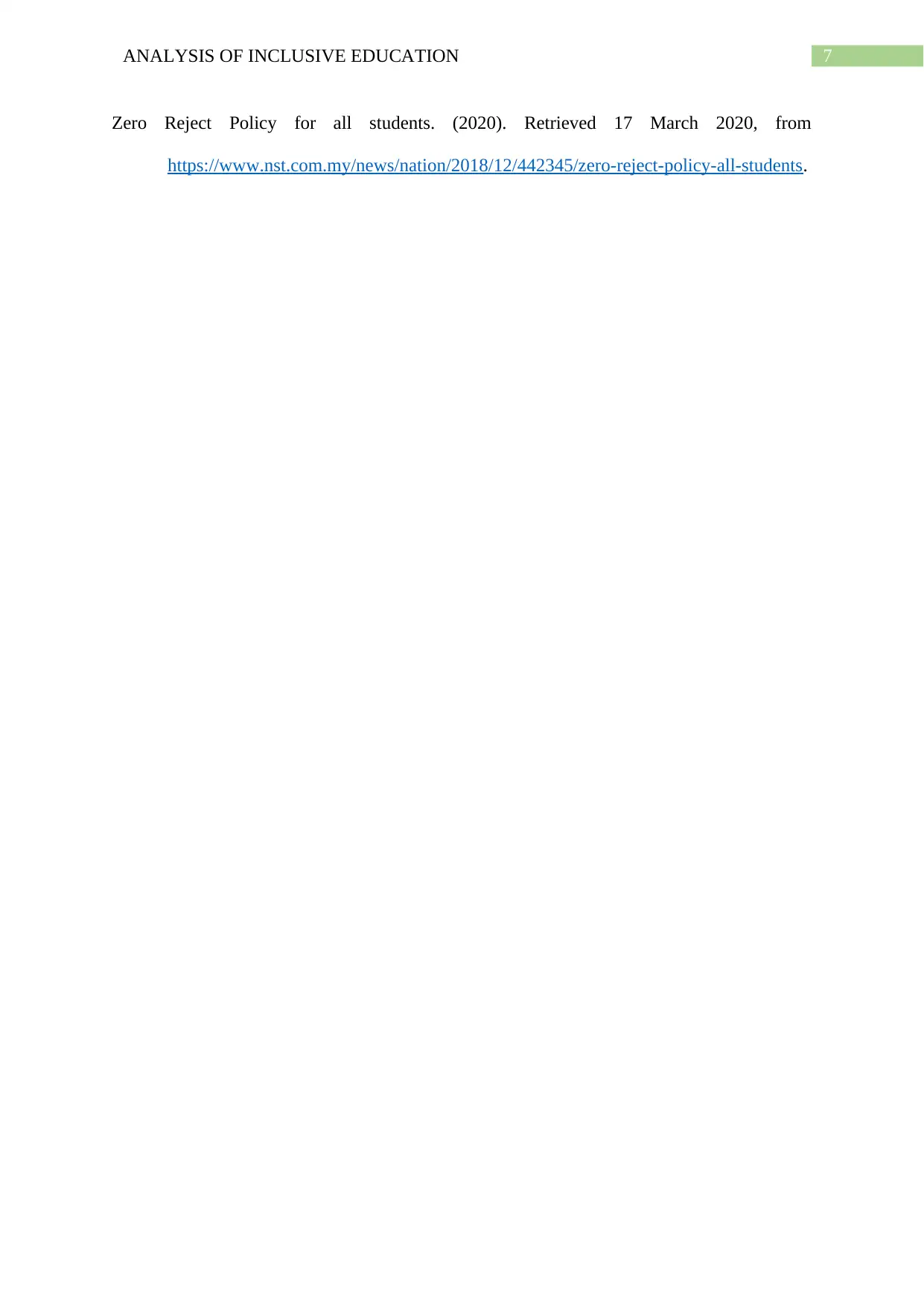
7ANALYSIS OF INCLUSIVE EDUCATION
Zero Reject Policy for all students. (2020). Retrieved 17 March 2020, from
https://www.nst.com.my/news/nation/2018/12/442345/zero-reject-policy-all-students.
Zero Reject Policy for all students. (2020). Retrieved 17 March 2020, from
https://www.nst.com.my/news/nation/2018/12/442345/zero-reject-policy-all-students.
1 out of 8
Related Documents
Your All-in-One AI-Powered Toolkit for Academic Success.
+13062052269
info@desklib.com
Available 24*7 on WhatsApp / Email
![[object Object]](/_next/static/media/star-bottom.7253800d.svg)
Unlock your academic potential
Copyright © 2020–2025 A2Z Services. All Rights Reserved. Developed and managed by ZUCOL.





